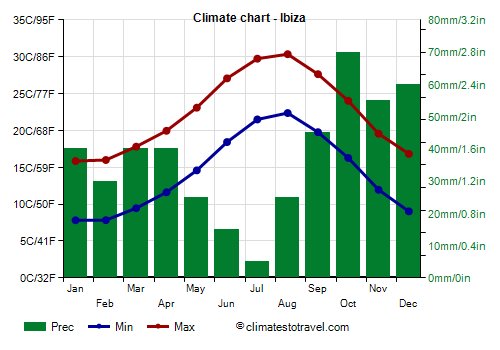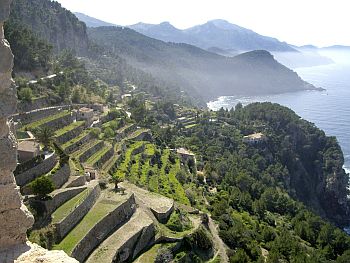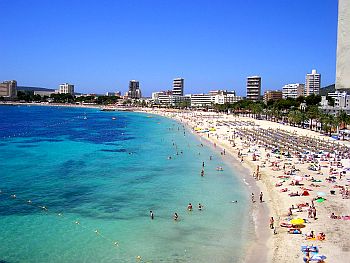Select units of measurement for the temperature and rainfall tables (metric or imperial).
Average weather, temperature, rainfall, sunshine hours
On the Balearic Islands, the climate is
Mediterranean, with mild winters and hot, sunny summers, a bit sultry but tempered by sea breezes.
The archipelago is located in the Mediterranean Sea east of the Iberian Peninsula and constitutes an Autonomous Community.

At sea level, the daily average
temperature ranges from 9/11 °C (48/52 °F) in January and February to about 25/26 °C (77/79 °F) in July and August.
Here are the average temperatures in Ibiza.
Ibiza - Average temperatures (1991-2020) |
| Month | Min | Max | Mean |
|---|
| January | 7.8 | 15.9 | 11.8 |
|---|
| February | 7.8 | 16 | 11.9 |
|---|
| March | 9.5 | 17.8 | 13.6 |
|---|
| April | 11.6 | 20 | 15.8 |
|---|
| May | 14.6 | 23.1 | 18.8 |
|---|
| June | 18.4 | 27.1 | 22.8 |
|---|
| July | 21.5 | 29.7 | 25.6 |
|---|
| August | 22.4 | 30.4 | 26.4 |
|---|
| September | 19.8 | 27.6 | 23.7 |
|---|
| October | 16.3 | 24 | 20.2 |
|---|
| November | 12 | 19.6 | 15.8 |
|---|
| December | 9 | 16.8 | 12.9 |
|---|
| Year | 14.3 | 22.4 | 18.25 |
|---|
is generally not abundant, since it amounts to 400/450 mm (15.5/17.5 in) per year on the coast, and follows the Mediterranean pattern, so it is more common in autumn and winter, and decreases gradually during spring, reaching a low in summer, when it almost never rains.
Here is the average rainfall recorded in Ibiza.
Ibiza - Average precipitation| Month | Days |
|---|
| January | 40 | 6 |
|---|
| February | 30 | 5 |
|---|
| March | 40 | 6 |
|---|
| April | 40 | 6 |
|---|
| May | 25 | 5 |
|---|
| June | 15 | 3 |
|---|
| July | 5 | 1 |
|---|
| August | 25 | 3 |
|---|
| September | 45 | 4 |
|---|
| October | 70 | 5 |
|---|
| November | 55 | 6 |
|---|
| December | 60 | 6 |
|---|
| Year | 450 | 56 |
|---|
The Balearic Islands are pretty
windy, especially from October to April, due to the mild, southwest wind that blows in bad weather, and to the northern wind that blows from France. In summer, sea breezes blow, but they are welcome because they make the heat more bearable.
Winter, from December to February, is mild, with many sunny days, but also with periods of rain and wind. Very cold days are rare, however, on the coldest nights of the year, the temperature generally drops to 1/2 °C (34/36 °F).
Summer, from June to mid-September, is typically Mediterranean, ie hot and sunny, with very rare rains. During the day, the sea breeze gives some relief, but nights are sultry. Highs can sometimes reach 35/36 °C (95/97 °F), especially in July and August.

In addition to these general features, there are some
differences that are worthy of note:
- The easternmost islands (Mallorca and Menorca), being closer to France, are the windiest ones.
-
Mallorca (or Majorca) is a bit more continental, that is, a bit colder in winter and warmer in summer. This happens both because it is larger and because there's a mountain range in the north,
Sierra de Tramontana, which somehow protects and isolates the inland plain. This mountain range, whose highest peak is
Puig Major, 1,445 meters (4,741 feet) high, is wetter and greener: precipitation reaches 1,200 millimeters (47 inches) per year, and in winter, it can snow.
-
Menorca (or Minorca), the easternmost island, is the rainiest, at least at sea level: rainfall reaches 600 mm (23.5 in) per year, although there are no hills or mountains. Usually, the difference is noticeable especially in autumn, when the rains can sometimes be abundant, and in winter, when there are periods when it rains often. In fact, Menorca is more prone to cold and rainy periods in winter.
-
Formentera and Ibiza, the southernmost and farthest from France, are slightly milder and less windy in the cold half-year.

The amount of
sunshine on the Balearic Islands is not bad, in fact, some sunny day can occur all year round, although it is better, as happens in Mediterranean climates, in late spring and summer, especially from May to August, when sunny days prevail. The annual total exceeds 2,600 hours of sunshine everywhere.
Here, for example, is the average number of hours of sunshine per day in Menorca.
@sole-Menorca
The temperature of the
sea is fairly uniform in the archipelago. The sea is warm enough for swimming from July to September, when the water temperature reaches or exceeds 24 °C (75 °F), while it is cool in June and October.
Here is the sea temperature in Ibiza.
Ibiza - Sea temperature| Month |
|---|
| January | 15 |
|---|
| February | 14 |
|---|
| March | 15 |
|---|
| April | 16 |
|---|
| May | 18 |
|---|
| June | 21 |
|---|
| July | 24 |
|---|
| August | 26 |
|---|
| September | 24 |
|---|
| October | 22 |
|---|
| November | 19"> |
|---|
| December | 16 |
|---|
| Year | 19.2 |
|---|
In Menorca, the most northern and most exposed to the north wind, the sea is just less warm in summer: it reaches 25 °C (77 °F) in August.
Best Time
The
best time for a beach holiday at the Balearics is the summer, from June to mid-September. The water temperature is comfortable enough July to September, although in September, which overall is still a good month (especially in the first half), the first Atlantic disturbances begin to affect the islands. May and June are sunny months, but the sea is still a bit cool, especially in May, when it is actually a bit cold, and sometimes, the air can be a little cold as well.
April and May are suitable months for visiting the islands and their cities, while in summer, it can sometimes be too hot for hiking. In October and November, temperatures are mild, but the days are shorter and the weather can be rainy and windy.